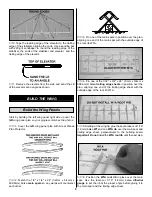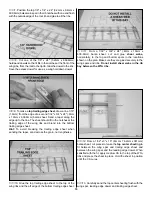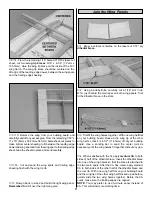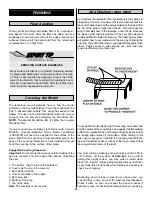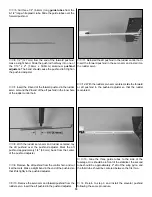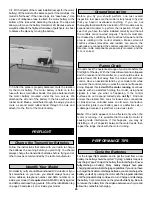
Because the BLT flies slowly, it requires little room to land.
Begin the landing approach by flying downwind at an
altitude of approximately 20 feet [6 meters]. When the
airplane is approximately 50 to 100 feet [15 to 30 meters]
past you, reduce the motor power and make the “final”
180-degree turn into the wind aligning the airplane with the
runway or landing area. Do not dive the airplane, as it will
pick up too much speed. Instead, when you cut the power,
allow the airplane to establish a gradual descent.
Concentrate on keeping it heading into the wind toward the
runway. When the plane reaches an altitude of about 4 feet
[1 meter], gently apply a little “up elevator” to level the
plane, but be careful as too much up elevator will cause it
to stall. While holding a slight amount of up elevator the
airplane will slow and descend as it loses flying speed, thus
touching down on the runway. For a smoother landing, use
a slight amount of motor power.
Some battery power should be reserved to help maneuver
the plane for landing.
When speaking of small models, frequently a takeoff from
the ground is called an “ROG” (
rise off ground
) takeoff.
Landings on grass will be a little rough, but doing a ROG
takeoff from grass will probably not be possible with the
BLT. If planning an ROG takeoff, find a paved surface.
After you have trimmed the BLT for flight and have become
familiar with its flight characteristics, you may execute ROG
takeoffs. With the model on the runway and pointing into the
wind, gently apply power. Initially, the plane may turn to the left
or right because it has not gained enough speed for the
controls to become effective. Do your best to get through this
brief moment and maintain a heading down the runway and
into the wind. Make corrections with the right stick of the
transmitter to keep it rolling straight into the wind. If the model
veers too far off, cut the throttle and try again. As the model
begins to gain speed the controls will become effective.
After the airplane has gained adequate speed (this requires
experience to gauge), gently pull back on the elevator stick
allowing the airplane to become airborne. Establish a gentle
climb the same as when you were hand-launching.
Best of luck and happy flying!
ROG (Rise off Ground) Takeoff
Landing
23
Use these tags to identify your models.
Содержание BLT
Страница 24: ...TWO VIEW...

